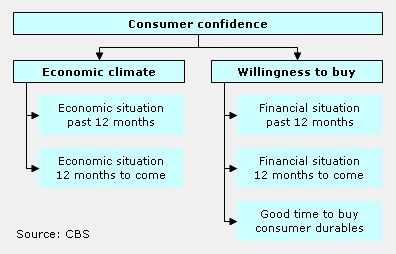household spending marginally up, consumer confidence remains stable

According to figures released by Statistics Netherlands today, household spending on goods and services was 0.2 percent up in October 2014 from October 2013. Prior to this modest increase, household spending was slightly down in September. Spending on durable consumer goods grew by most. Consumer confidence remained fairly stable in December.
Consumption figures have been adjusted for price changes and differences in the shopping-day pattern.
Domestic household consumption (volume, adjusted for shopping-days)

Spending on household appliances and home furnishing articles up by most
Household spending on durable goods was 2.6 percent higher than twelve months previously. Consumers spent more on household appliances and home furnishing articles in particular. They also bought more bicycles and motor bikes. Last Tuesday, Statistics Netherlands already stated that electronics sales were substantially up in October. Consumers also spent more in home furnishing and DIY shops.
Dutch consumers spent approximately the same amount on food, drinks and tobacco products as last year, whereas spending on other goods (including natural gas and motor fuels) was down by 4.2 percent. Household spending on services, accounting for more than half of domestic consumption, grew by 0.7 percent.
Domestic household consumption by category (volume, adjusted for shopping-days), October 2014

Circumstances for consumption in December about the same as in November
On balance, circumstances for consumption remained stable in December according to the Household Consumption Radar. The rise in Dutch share prices compared to one year previously was larger than in the preceding month. House prices (excluding new construction) also rose by slightly more than twelve months previously. The decrease in the labour force was smaller than in the previous month. On the other hand, Dutch consumers were more pessimistic about future unemployment. By means of six indicators, the Household Consumption Radar shows whether circumstances for Dutch household consumption have become more or less favourable.
Consumer confidence remains fairly stable
The mood among consumers improved marginally in December from November. Consumer confidence was -7 in December, versus -8 in the preceding month. Consumers’ opinions about the economic climate and their willingness-to-buy remained virtually unchanged.
At -7, consumer confidence in December is slightly above its long-term average for the past two decades (-8). Consumer confidence reached the highest level ever in April 2000 (27) and reached its lowest point in February 2013 (- 44).
Consumer confidence, seasonally adjusted

Opinions about economic climate and willingness-to-buy remain stable
The component indicator Economic climate was -3, versus -4 in November.The component indicator willingness-to-buy remained stable from November to December at -10.
Consumer confidence

More figures can be found in dossier Business cycle.
For more information on economic indicators, see the Economic Monitor.